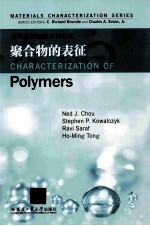

聚合物的表征 英文PDF电子书下载
- 电子书积分:12 积分如何计算积分?
- 作 者:(美)布伦德尔,(美)埃文斯,(美)周主编
- 出 版 社:哈尔滨:哈尔滨工业大学出版社
- 出版年份:2014
- ISBN:9787560342849
- 页数:319 页
POLYMER STRUCTURES AND SYNTHESIS METHODS 1
1.1 Introduction 1
1.2 Chain Structures in Natural and Synthetic Polymers 1
The Nature of Polymeric Materials 1
The Composition of Polymeric Materials 3
Molecular Weight and Its Distribution 11
Polymer Chain Configurations 12
Polymer Chain Conformations 14
Polymer Solid-State Structure,Morphology,and Transitions 15
Polymer Surface Structure 18
1.3 Polymer Synthesis 20
Chain Reaction Polymerization 21
Coordination Polymerization 24
Step Reaction Polymerization 25
1.4 Summary 26
POLYMER FABRICATION TECHNIQUES 28
2.1 Introduction 28
2.2 Processing Techniques 29
Foam Processing 31
Film-Forming Processes 31
Composites 32
Extrusion 34
Molding 35
Coatings 36
Other Methods 37
2.3 Applications 37
Development of Spray-On Insulation for the Thermal Protection System of the External Tank in the Space Shuttle Program 37
Development of Thick,Thin,and Ultrathin Polyimide Films 40
Langmuir-Blodgett(L-B)Films 47
Polymer Composites 49
Molding Processes 55
Fiber Drawing and Surface Modification Processes 56
CHEMICAL COMPOSITION OF POLYMERS 65
3.1 Introduction 65
3.2 Chemical Composition:Questions to Ask 66
3.3 Techniques for Determination of Chemical Composition:What to Use to Ask the Questions 67
3.4 Illustrative Examples of Characterization of Chemical Composition of Polymers 72
Stoichiometry 72
Functionality 73
Phase Separation 80
Surface Modification 81
Interfacial Chemical Composition 83
Impurities 83
3.5 Summary:New Horizons 86
CHARACTERIZATION OF THE MORPHOLOGY OF POLYMER SURFACES,INTERFACES,AND THIN FILMS BY MICROSCOPY TECHNIQUES 92
4.1 Overview of Polymer Interfaces and Thin Films 92
4.2 Introduction to Microscopy Techniques 93
4.3 Optical Microscopy 94
4.4 Scanning Electron Microscopy 98
Low-Voltage High-Resolution Scanning Electron Microscopy 100
Environmental Scanning Electron Microscopy 104
4.5 Transmission Electron Microscopy 106
4.6 Scanning Probe Microscopy 111
4.7 New Microscopies 116
STRUCTURE AND MORPHOLOGY OF INTERFACES AND THIN FILMS BY SCATTERING TECHNIQUES 121
5.1 Introduction 121
5.2 Industrial Applications 122
Adhesion 122
Biomedical Applications 124
Langmuir-Blodgett Films and Other Thin Films 125
5.3 Integrated Optics Method 127
Wave-Guiding 127
Nonlinear Optical Method 130
5.4 Reflectivity 136
5.5 Grazing Incidence X-Ray Scattering 139
SURFACE THERMODYNAMICS 150
6.1 Introduction 150
6.2 Theory of Wetting,Spreading,and Adhesion 151
6.3 Experimental Methods 154
Contact Angles 154
Adsorption and Calorimetry 157
Inverse Gas Chromatography 162
Infrared(FTIR)Spectroscopy 164
SURFACE MODIFICATION OF POLYMERS 169
7.1 Introduction 169
7.2 Wet-Chemical Modification of Polymer Surfaces 171
Surface Roughening and Seeding in Placing Operations 171
Surface Treatment for Bondability 173
Surface Treatment Using Adhesion Promoters 175
Surface Modification by Photochemical Methods 177
7.3 Dry Modification Techniques 179
Modification by High-and Low-Energy Ion Beams 179
Plasma Modification of Polymer Surfaces 187
Other Dry Treatment Techniques 191
7.4 Summary 192
ADHESION 198
8.1 Introduction 198
8.2 Physical Meaning of Adhesion 200
8.3 Theoretical Analysis of Adhesion 200
8.4 Experimental Measurement of Adhesion 203
8.5 Standardization of Test Procedure 205
8.6 Locus of Failure 205
8.7 Key Adhesion Issues 207
8.8 Illustrative Examples 208
8.9 Summary 209
CHEMISTRY,REACTIVITY,AND FRACTURE OF POLYMER INTERFACES 215
9.1 Introduction 215
9.2 Polyimide Structure and Properties 218
9.3 Polymer-Polymer Interfaces 222
9.4 Metal-Polymer Interfaces 224
9.5 Polymer-Metal Interfaces 230
9.6 Thermal Stress and Interfacial Fracture 234
THE POLYMER-POLYMER INTERFACE 244
10.1 Introduction 244
10.2 Techniques for Measuring Diffusion Distances Much Greater Than Molecular Size 247
10.3 Techniques for Measuring Concentration Profiles on the Order of Molecular Size 252
10.4 Summary 259
FRICTION AND WEAR(TRIBOLOGY) 262
11.1 Introduction 262
11.2 Basic Concepts 263
11.3 Tribological Applications 264
11.4 Mechanisms of Friction and Wear 265
Friction 266
Wear 268
11.5 Correlation of Properties with Friction and Wear 269
Energy-to-Rupture and Abrasive Wear 269
Cohesive Energy and Abrasive Wear 271
Ratio of Applied Stress to Failure Strength and Wear 271
Molecular Weight and Wear 271
Crystallinity and Wear 273
Loss Tangent and Friction 273
Closure 274
11.6 Measurement of Friction and Wear 274
ASTM Laboratory Tests 276
Designing Laboratory Tests 284
11.7 Reporting and Interpretation of Measurements 291
11.8 Summary 293
REFERENCES FOR FUTURE STUDY 295
Index 311
- 《中国综合性大学法语学科表征研究》田园著 2019
- 《基于聚合物的多功能纳米复合材料》宋克男,刘春太,(美)郭占虎主编 2019
- 《Laves相NbCr2化合物的力学性能及其应用》刘昕责编;聂小武 2019
- 《英汉程式语心理表征对比研究》贾冠杰,王云,李更春 2019
- 《螺旋配位聚合物》刘崇波著 2019
- 《3D动画电影研究 本体理论与文化表征 新艺述》孙振涛 2019
- 《聚合物化学原理》(美)保罗·约翰·弗洛里著 2020
- 《基于超支化聚合物制备纳米晶体与诱导纳米晶体组装》石云峰著 2019
- 《二维化合物的吸附特性》琚伟伟著 2020
- 《时间的概念化及其语言表征研究》肖燕著 2019
- 《高考快速作文指导》张吉武,鲍志伸主编 2002
- 《建筑施工企业统计》杨淑芝主编 2008
- 《SQL与关系数据库理论》(美)戴特(C.J.Date) 2019
- 《钒产业技术及应用》高峰,彭清静,华骏主编 2019
- 《近代旅游指南汇刊二编 16》王强主编 2017
- 《魔法销售台词》(美)埃尔默·惠勒著 2019
- 《看漫画学钢琴 技巧 3》高宁译;(日)川崎美雪 2019
- 《汉语词汇知识与习得研究》邢红兵主编 2019
- 《优势谈判 15周年经典版》(美)罗杰·道森 2018
- 《黄遵宪集 4》陈铮主编 2019
